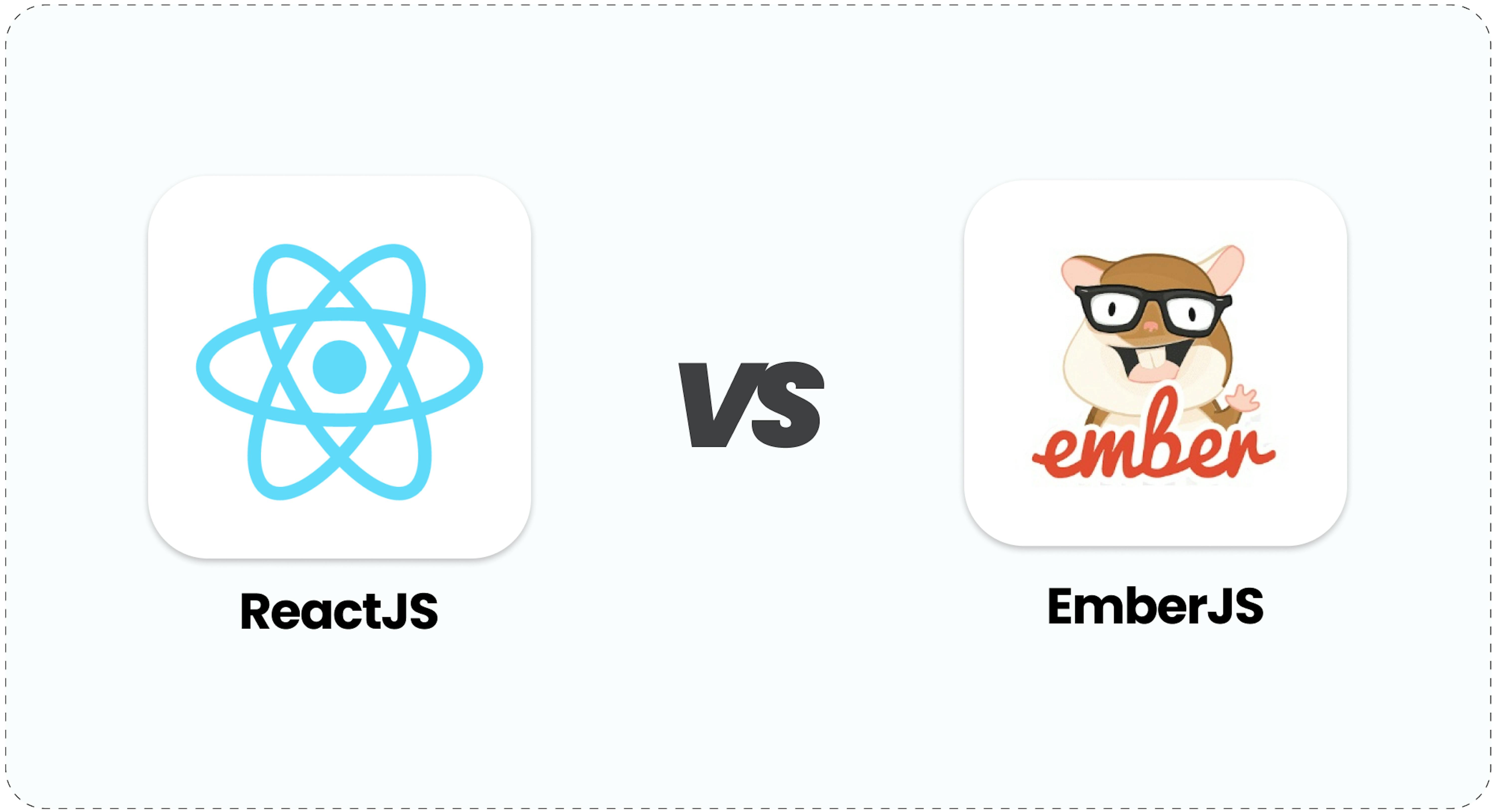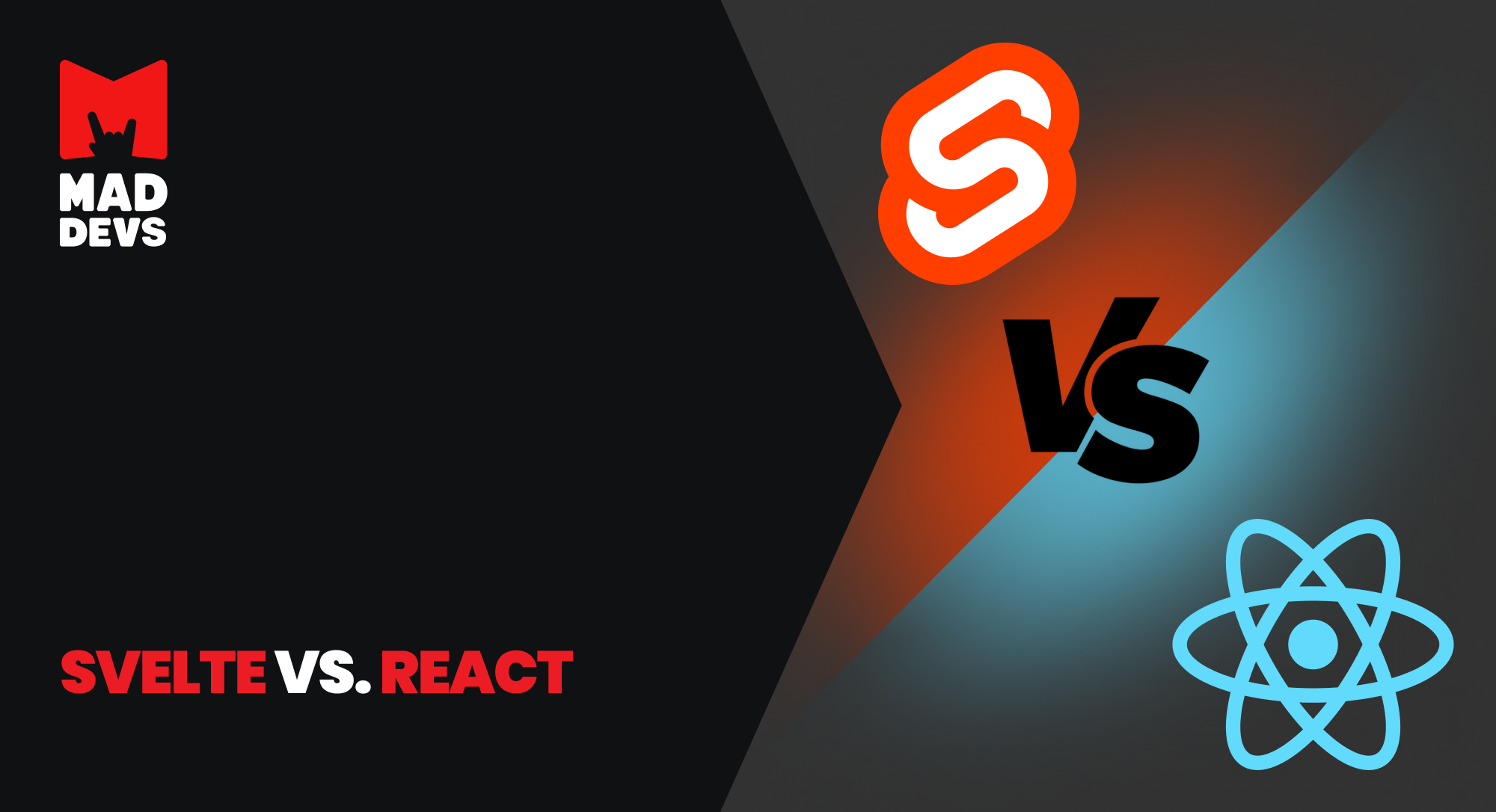Selecting the right frontend framework is key to ensuring a smooth user experience and achieving overall project success.
React JS and Ember JS are two widely used frontend technologies in modern web development. While both are based on JavaScript and share the goal of simplifying the development process, they have distinct approaches and characteristics that make them suitable for different use cases.
This article compares frameworks to help you decide which is best for your project.

EmberJS vs. ReactJS: Philosophy
Ember.js takes an opinionated approach, enforcing conventions and best practices to maintain a structured, consistent codebase. This philosophy streamlines development and promotes stability, making Ember.js ideal for large-scale applications where a cohesive ecosystem, strong conventions, and built-in features are prioritized. However, this approach can limit flexibility for projects that require more customization.
React.js follows a component-based philosophy, where developers create modular, reusable components that enhance adaptability and flexibility. While this approach may require more upfront planning, it provides greater control over the project. React.js is suited for large-scale applications needing a flexible architecture and access to a broad selection of libraries and tools that can be customized to meet specific requirements.
EmberJS vs. ReactJS: Data management
Ember.js: One of the strengths of Ember.js is its built-in two-way data binding. This feature allows the UI to automatically update whenever the underlying data changes and vice versa, ensuring that the view and data are always synchronized without requiring additional code. This simplifies data management and reduces the complexity of keeping track of state changes, especially in applications where data frequently changes or must be shared across multiple components. It has a more declarative coding style, meaning developers don't need to write code explicitly to update the UI when the data model changes, making the development process more efficient and less error-prone.
React.js: React, on the other hand, follows a one-way data flow paradigm, which means that updates to the UI are handled explicitly through state changes. This gives developers more control over managing and propagating data throughout the application. While this can lead to cleaner and more predictable data flows in simple applications, it can become more complex in larger applications, especially when dealing with nested components or shared states. Developers need to manually manage states through hooks like useState, useReducer, or libraries like Redux or MobX for more advanced state management.
EmberJS vs. ReactJS: Routing
Ember.js: One of Ember's core strengths is its built-in, convention-over-configuration routing system. This feature simplifies navigation between different views and automatically handles common tasks like managing application state and transitions. Since routing is tightly integrated into the framework, developers don't need to set up additional tools or configurations, making it easier to create complex single-page applications (SPAs) with smooth transitions and deep linking capabilities. Ember's router follows RESTful conventions, allowing for easy URL management, and it provides features like nested routes and query parameters, which are all streamlined and accessible out of the box.
React.js: React, being a more flexible and lightweight library, doesn't come with built-in routing functionality. Instead, it relies on external libraries, such as React Router, to handle routing. While this adds a dependency, it also gives developers more control and flexibility in implementing routing. React Router allows you to manage dynamic routing, control route rendering, and access advanced features like route transitions, lazy loading, and programmatic navigation. However, it requires more setup than Ember, and developers must explicitly configure and manage routing behavior as part of their app's architecture.
EmberJS vs. ReactJS: Bundle size
EmberJS: It is relatively compact, at around 100KB when minified and gzipped. In contrast, ReactJS: It has a smaller footprint, with the core library (including React and ReactDOM) coming in at approximately 40KB when minified and gzipped, but this is without any additional libraries.
EmberJS vs. ReactJS: Speed and performance
EmberJS: EmberJS comes with several built-in optimizations to improve performance out of the box. One key feature is lazy loading, which allows applications to load only the essential parts of the code when needed, rather than loading everything upfront. This can significantly reduce initial load times, especially for larger applications. Additionally, Ember's two-way data binding automatically keeps the UI in sync with the data model, optimizing how updates are handled without requiring manual intervention. Ember's built-in conventions, such as efficient routing, templates, and state management, also contribute to faster development while maintaining a smooth user experience. These optimizations provide developers with a set of tools to achieve better performance without needing to manually implement such features.
ReactJS: ReactJS focuses on performance with its highly efficient virtual DOM. Instead of directly manipulating the real DOM (which can be slow), React creates a lightweight virtual representation of the DOM in memory. React calculates the minimal set of updates needed when changes occur by comparing the new virtual DOM with the previous one. This process, known as reconciliation, allows React to update only the parts of the real DOM that have changed, minimizing costly DOM manipulations and leading to noticeable performance gains, particularly in applications with frequent updates or complex UIs.
EmberJS vs. ReactJS: Learning curve
Ember.js: Due to its opinionated nature, Ember.js has a steeper learning curve. You need to learn its conventions and patterns to be productive.
React.js: With a focus on core concepts like components and state management, React.js offers a shallower learning curve. While building complex features might require additional libraries, the core concepts are relatively easy to grasp.
EmberJS vs. ReactJS: Popularity and community
ReactJS: React JS has quickly secured a 39.5% market share, making it the second most popular web framework. Backed by Facebook (Meta), it has a massive user base and is widely adopted by developers and organizations. React's flexibility, performance, and ecosystem make it the go-to choice for many.
React has a vast and highly active community. There is a wealth of resources, tutorials, third-party libraries, and tools built around React, making it easier for developers to find support and extend the library's functionality. Its popularity on platforms like GitHub, Stack Overflow, and various forums ensures continuous community-driven improvements and support.
EmberJS: It has not achieved the level of popularity one might expect, with less than 0.1% of all websites relying on this framework. Does anyone still use EmberJS? On GitHub, Ember.js boasts 22.4K stars and 4.3K forks, indicating a respectable level of interest and engagement within the developer community. The official Ember community consists of 7.8K members, providing a solid support network. Additionally, Ember has a virtual Discord space where over 6K developers interact.
EmberJS vs. ReactJS: Summary
| FEATURE | EMBER.JS | REACT.JS |
|---|---|---|
| Type | Framework | Library |
| Data binding | Two-way data binding | One-way (can be extended for two-way) |
| Backed by | Community | Meta |
| Architecture | Model-View-Controller | View |
| Automatic view filtering | Yes | No |
| Routing & deep linking support | Yes (built-in) | No (requires external libraries) |
| Server-side frameworks often used with | Rails, Spring/Java, PHP, and .Net | Node.js, Java, .Net |
| Plain JavaScript models | No | Yes |
| Dependency injection | Yes | No |
| Server-side rendering | No | Yes |
| DOM manipulation | Limited to Ember’s framework | Library-agnostic |
| Promises | Yes | No (requires external libraries) |
| Extensibility | Opinionated, limited flexibility | Highly flexible and customizable |
| Community | 7.8K members | 55 million members |
| Weight | 100kb | 40kb |
| Learning curve | Steep | Gradual |
| Best for | Building modern web applications with rich UIs that work on any device | Interactive applications for mobile, web, and other platforms |
Why choose Ember over React?
When considering why to choose EmberJS over ReactJS, several advantages of Ember's stand out:
Ember offers a more integrated ecosystem, which simplifies the process of upgrades and maintenance.
One of Ember's primary goals is to minimize the minor differences between applications. This allows developers to focus more on implementing features rather than dealing with repetitive configuration and boilerplate code. For instance, essential features like state management and routing have been integral to Ember since its inception, whereas similar features in Next.js have only recently been introduced.
Ember's Discord community is an invaluable resource for developers seeking help and advice. Although it can sometimes reflect a US workweek-centric culture, it provides a more welcoming atmosphere compared to the larger and more chaotic React Discord server. The Ember Discord is an excellent place to receive synchronous support from knowledgeable members outside your immediate team.
Ember prioritizes conventions, which serve as best-practice defaults that enhance productivity. By providing clear guidance, these conventions help developers quickly adapt and start building applications, leading to faster development times and a smoother onboarding process for new team members.
While React also claims to be primarily JavaScript, this can be misleading, especially with the heavy reliance on hooks and patterns like useEffect. Many developers find themselves writing more React-specific code than pure JavaScript. In contrast, Ember encourages developers to stick to standard JavaScript for most functionality, focusing on reactivity and routing as its primary deviations. This allows developers to leverage their existing JavaScript knowledge without becoming overly entrenched in the framework's specifics.
To wrap up
Both frameworks offer powerful tools for modern web development, but understanding their unique strengths and trade-offs is key to making the right decision.
Choosing between EmberJS and ReactJS depends on your project's specific needs, team expertise, and long-term goals. If you value a structured, all-in-one framework with built-in features and strong conventions, EmberJS may be the better choice. For projects that require flexibility, adaptability, and a component-based architecture, ReactJS might be the right fit.
We specialize in building high-quality, scalable web applications with various technologies at Mad Devs. Whether you're leaning towards EmberJS or ReactJS, we can guide you through the decision-making process and help you achieve your project goals.
Contact us today for a free consultation.










